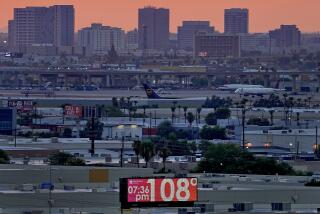Phoenix’s too hot future
If cities were stocks, you’d want to short Phoenix.
Of course, it’s an easy city to pick on. The nation’s 13th-largest metropolitan area crams 4.3 million people into a low bowl in a hot desert, where horrific heat waves and windstorms visit it regularly. And it depends on an improbable infrastructure to suck water from the distant (and dwindling) Colorado River.
If the Gulf Coast’s Hurricane Katrina and the Eastern Seaboard’s Superstorm Sandy previewed how coastal cities can expect to fare as seas rise and storms strengthen, Phoenix — which also stands squarely in the cross hairs of climate change — pulls back the curtain on the future of inland empires. If you want a taste of the brutal new climate to come, look no further than the aptly named Valley of the Sun.
PHOTO ESSAY: Seven states, seven warning signs of global warming
In Phoenix, the convergence of heat, drought and violent winds is creating an ever-more-worrisome situation. Let’s take heat first. If, in summer, the grid there were to fail on a large scale and for a significant period of time, the fallout would make the consequences of Sandy look mild. Phoenix is an air-conditioned city. If the power goes out, people fry.
In the summer of 2003, a heat wave swept Europe and killed 70,000 people. The temperature in London touched 100 degrees Fahrenheit for the first time since records had been kept, and in portions of France, the mercury climbed as high as 104. Those temperatures, however, are child’s play in Phoenix, where readings commonly exceed 100 degrees for more than 100 days a year. In 2011, the city set a record for days over 110. There were 33 of them.
It goes without saying that Phoenix’s desert setting is hot by nature, but humans have made it hotter. The city is a masonry world, with asphalt and concrete everywhere. The hard, heavy materials absorb daytime heat more efficiently than the naked land, and then give it back more slowly after the sun goes down, preventing the cool of the desert night from providing much relief.
Sixty years ago, nighttime lows never crept above 90. Today such temperatures are a commonplace, and the vigil has begun for the first night that doesn’t dip below 100.
And heat is a tricky adversary. It stresses everything, including electrical equipment. Transformers, when they get too hot, can fail, and thermoelectric generating becomes less efficient.
And the great hydroelectric dams of the Colorado River, including Glen Canyon, which serves greater Phoenix, won’t be able to supply the “peaking power” they do now if the reservoirs behind them are fatally shrunken by drought, as multiple studies forecast they will be. Not to worry, say the two major utilities serving the Phoenix metroplex, Arizona Public Service and the Salt River Project: Much of this can be mitigated with upgraded equipment, smart-grid technologies and redundant systems. And they have managed to keep outages brief. So far.
But before Katrina hit, the Army Corps of Engineers was similarly reassuring to the people of New Orleans. And until Superstorm Sandy landed, almost no one worried about storm surges filling the subway tunnels of New York. Every system, like every city, has its vulnerabilities. Climate change, in almost every instance, intensifies them.
One looming vulnerability for Phoenix is that the beefed-up, juiced-up, greenhouse-gassed overheated weather of the future is likely to send the city violent dust storms of a sort we can’t yet imagine, packed with ever greater amounts of energy. Already Phoenix is seeing more intense dust storms that bring visibility to zero and life to a standstill.
There is also, of course, the problem of water. In dystopian portraits of Phoenix’s unsustainable future, water — or rather the lack of it — is usually painted as the agent of collapse. Indeed, the metropolitan area, a jumble of jurisdictions that includes Scottsdale, Glendale, Tempe, Mesa, Sun City, Chandler and 15 other municipalities, has tapped groundwater supplies at unsustainable rates.
All along, everyone knew that couldn’t last, so in the early 1990s, a new bonanza called the Central Arizona Project (CAP) was brought on line — a river-sized, open-air canal supported by an elaborate array of pumps, siphons and tunnels to bring Colorado River water to Phoenix and Tucson.
Today, the project is the engine of Arizona’s growth. Unfortunately, to win authorization and funding to build it, state officials had to make a bargain with the devil, which in this case turned out to be California. The concession California forced on Arizona was simple: It had to agree that its CAP water rights would take second place to California’s claims.
A raw deal for Arizona? You bet, but not exactly the end of the line. Arizona has other “more senior” rights to the Colorado, and when the CAP water begins to run dry, you may be sure that its masters will pay whatever is necessary to lease those older rights and keep the 330-mile canal flowing.
Longer term, if habits don’t change, the Colorado River poses issues that no water claims can resolve. Beset by climate change, overuse and drought, the river and its reservoirs, according to various researchers, may decline to the point that water fails to pass Hoover Dam. In that case, the CAP system would dry up, but so would the Colorado Aqueduct, which serves greater Los Angeles and San Diego, as well as the All-American Canal, on which the factory farms of California’s Imperial and Coachella valleys depend.
These are giant problems that cities and the region as a whole must rally to face, a prospect that brings up another issue: Communities that survive stern challenges are those that learn how to pull together. Phoenix’s winner-take-all politics, exemplified by Sheriff Joe Arpaio’s storm-trooper tactics, give little cause for optimism. A few decades hence, after the climate screws have tightened with excruciating force, don’t be surprised if the drivers steering U-Hauls out of town are spurred along as much by discord as by drought.
William deBuys is the author of “A Great Aridness: Climate Change and the Future of the American Southwest.” A longer version of this piece appears at tomdispatch.com.
More to Read
A cure for the common opinion
Get thought-provoking perspectives with our weekly newsletter.
You may occasionally receive promotional content from the Los Angeles Times.






